Input interpretation

Mg(NO_3)_2 (magnesium nitrate) ⟶ O_2 (oxygen) + NO_2 (nitrogen dioxide) + MgO (magnesium oxide)
Balanced equation
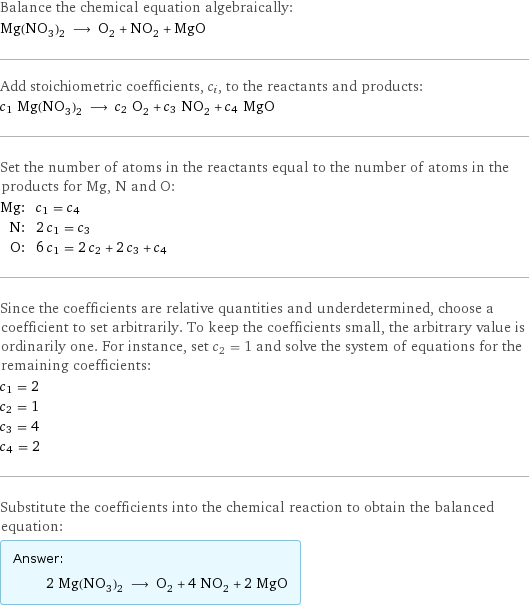
Balance the chemical equation algebraically: Mg(NO_3)_2 ⟶ O_2 + NO_2 + MgO Add stoichiometric coefficients, c_i, to the reactants and products: c_1 Mg(NO_3)_2 ⟶ c_2 O_2 + c_3 NO_2 + c_4 MgO Set the number of atoms in the reactants equal to the number of atoms in the products for Mg, N and O: Mg: | c_1 = c_4 N: | 2 c_1 = c_3 O: | 6 c_1 = 2 c_2 + 2 c_3 + c_4 Since the coefficients are relative quantities and underdetermined, choose a coefficient to set arbitrarily. To keep the coefficients small, the arbitrary value is ordinarily one. For instance, set c_2 = 1 and solve the system of equations for the remaining coefficients: c_1 = 2 c_2 = 1 c_3 = 4 c_4 = 2 Substitute the coefficients into the chemical reaction to obtain the balanced equation: Answer: | | 2 Mg(NO_3)_2 ⟶ O_2 + 4 NO_2 + 2 MgO
Structures

⟶ + +
Names

magnesium nitrate ⟶ oxygen + nitrogen dioxide + magnesium oxide
Reaction thermodynamics
Enthalpy
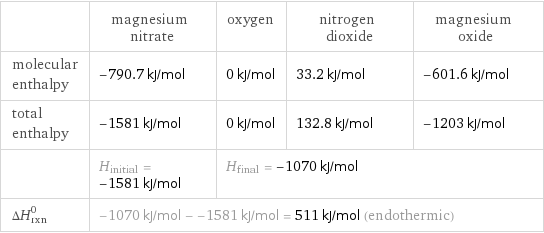
| magnesium nitrate | oxygen | nitrogen dioxide | magnesium oxide molecular enthalpy | -790.7 kJ/mol | 0 kJ/mol | 33.2 kJ/mol | -601.6 kJ/mol total enthalpy | -1581 kJ/mol | 0 kJ/mol | 132.8 kJ/mol | -1203 kJ/mol | H_initial = -1581 kJ/mol | H_final = -1070 kJ/mol | | ΔH_rxn^0 | -1070 kJ/mol - -1581 kJ/mol = 511 kJ/mol (endothermic) | | |
Gibbs free energy
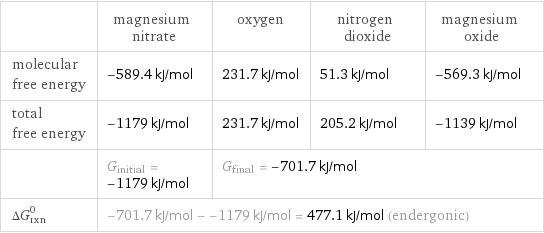
| magnesium nitrate | oxygen | nitrogen dioxide | magnesium oxide molecular free energy | -589.4 kJ/mol | 231.7 kJ/mol | 51.3 kJ/mol | -569.3 kJ/mol total free energy | -1179 kJ/mol | 231.7 kJ/mol | 205.2 kJ/mol | -1139 kJ/mol | G_initial = -1179 kJ/mol | G_final = -701.7 kJ/mol | | ΔG_rxn^0 | -701.7 kJ/mol - -1179 kJ/mol = 477.1 kJ/mol (endergonic) | | |
Equilibrium constant
![Construct the equilibrium constant, K, expression for: Mg(NO_3)_2 ⟶ O_2 + NO_2 + MgO Plan: • Balance the chemical equation. • Determine the stoichiometric numbers. • Assemble the activity expression for each chemical species. • Use the activity expressions to build the equilibrium constant expression. Write the balanced chemical equation: 2 Mg(NO_3)_2 ⟶ O_2 + 4 NO_2 + 2 MgO Assign stoichiometric numbers, ν_i, using the stoichiometric coefficients, c_i, from the balanced chemical equation in the following manner: ν_i = -c_i for reactants and ν_i = c_i for products: chemical species | c_i | ν_i Mg(NO_3)_2 | 2 | -2 O_2 | 1 | 1 NO_2 | 4 | 4 MgO | 2 | 2 Assemble the activity expressions accounting for the state of matter and ν_i: chemical species | c_i | ν_i | activity expression Mg(NO_3)_2 | 2 | -2 | ([Mg(NO3)2])^(-2) O_2 | 1 | 1 | [O2] NO_2 | 4 | 4 | ([NO2])^4 MgO | 2 | 2 | ([MgO])^2 The equilibrium constant symbol in the concentration basis is: K_c Mulitply the activity expressions to arrive at the K_c expression: Answer: | | K_c = ([Mg(NO3)2])^(-2) [O2] ([NO2])^4 ([MgO])^2 = ([O2] ([NO2])^4 ([MgO])^2)/([Mg(NO3)2])^2](../image_source/56dfe06c8ec3b16b771a5097180a03ce.png)
Construct the equilibrium constant, K, expression for: Mg(NO_3)_2 ⟶ O_2 + NO_2 + MgO Plan: • Balance the chemical equation. • Determine the stoichiometric numbers. • Assemble the activity expression for each chemical species. • Use the activity expressions to build the equilibrium constant expression. Write the balanced chemical equation: 2 Mg(NO_3)_2 ⟶ O_2 + 4 NO_2 + 2 MgO Assign stoichiometric numbers, ν_i, using the stoichiometric coefficients, c_i, from the balanced chemical equation in the following manner: ν_i = -c_i for reactants and ν_i = c_i for products: chemical species | c_i | ν_i Mg(NO_3)_2 | 2 | -2 O_2 | 1 | 1 NO_2 | 4 | 4 MgO | 2 | 2 Assemble the activity expressions accounting for the state of matter and ν_i: chemical species | c_i | ν_i | activity expression Mg(NO_3)_2 | 2 | -2 | ([Mg(NO3)2])^(-2) O_2 | 1 | 1 | [O2] NO_2 | 4 | 4 | ([NO2])^4 MgO | 2 | 2 | ([MgO])^2 The equilibrium constant symbol in the concentration basis is: K_c Mulitply the activity expressions to arrive at the K_c expression: Answer: | | K_c = ([Mg(NO3)2])^(-2) [O2] ([NO2])^4 ([MgO])^2 = ([O2] ([NO2])^4 ([MgO])^2)/([Mg(NO3)2])^2
Rate of reaction
![Construct the rate of reaction expression for: Mg(NO_3)_2 ⟶ O_2 + NO_2 + MgO Plan: • Balance the chemical equation. • Determine the stoichiometric numbers. • Assemble the rate term for each chemical species. • Write the rate of reaction expression. Write the balanced chemical equation: 2 Mg(NO_3)_2 ⟶ O_2 + 4 NO_2 + 2 MgO Assign stoichiometric numbers, ν_i, using the stoichiometric coefficients, c_i, from the balanced chemical equation in the following manner: ν_i = -c_i for reactants and ν_i = c_i for products: chemical species | c_i | ν_i Mg(NO_3)_2 | 2 | -2 O_2 | 1 | 1 NO_2 | 4 | 4 MgO | 2 | 2 The rate term for each chemical species, B_i, is 1/ν_i(Δ[B_i])/(Δt) where [B_i] is the amount concentration and t is time: chemical species | c_i | ν_i | rate term Mg(NO_3)_2 | 2 | -2 | -1/2 (Δ[Mg(NO3)2])/(Δt) O_2 | 1 | 1 | (Δ[O2])/(Δt) NO_2 | 4 | 4 | 1/4 (Δ[NO2])/(Δt) MgO | 2 | 2 | 1/2 (Δ[MgO])/(Δt) (for infinitesimal rate of change, replace Δ with d) Set the rate terms equal to each other to arrive at the rate expression: Answer: | | rate = -1/2 (Δ[Mg(NO3)2])/(Δt) = (Δ[O2])/(Δt) = 1/4 (Δ[NO2])/(Δt) = 1/2 (Δ[MgO])/(Δt) (assuming constant volume and no accumulation of intermediates or side products)](../image_source/669dc7f948e6a6ddac05bc3fcd66ddb6.png)
Construct the rate of reaction expression for: Mg(NO_3)_2 ⟶ O_2 + NO_2 + MgO Plan: • Balance the chemical equation. • Determine the stoichiometric numbers. • Assemble the rate term for each chemical species. • Write the rate of reaction expression. Write the balanced chemical equation: 2 Mg(NO_3)_2 ⟶ O_2 + 4 NO_2 + 2 MgO Assign stoichiometric numbers, ν_i, using the stoichiometric coefficients, c_i, from the balanced chemical equation in the following manner: ν_i = -c_i for reactants and ν_i = c_i for products: chemical species | c_i | ν_i Mg(NO_3)_2 | 2 | -2 O_2 | 1 | 1 NO_2 | 4 | 4 MgO | 2 | 2 The rate term for each chemical species, B_i, is 1/ν_i(Δ[B_i])/(Δt) where [B_i] is the amount concentration and t is time: chemical species | c_i | ν_i | rate term Mg(NO_3)_2 | 2 | -2 | -1/2 (Δ[Mg(NO3)2])/(Δt) O_2 | 1 | 1 | (Δ[O2])/(Δt) NO_2 | 4 | 4 | 1/4 (Δ[NO2])/(Δt) MgO | 2 | 2 | 1/2 (Δ[MgO])/(Δt) (for infinitesimal rate of change, replace Δ with d) Set the rate terms equal to each other to arrive at the rate expression: Answer: | | rate = -1/2 (Δ[Mg(NO3)2])/(Δt) = (Δ[O2])/(Δt) = 1/4 (Δ[NO2])/(Δt) = 1/2 (Δ[MgO])/(Δt) (assuming constant volume and no accumulation of intermediates or side products)
Chemical names and formulas
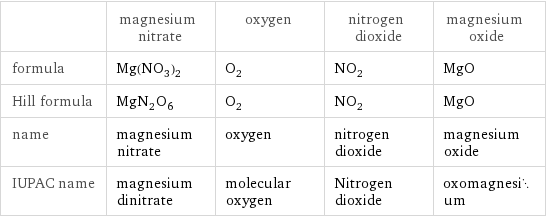
| magnesium nitrate | oxygen | nitrogen dioxide | magnesium oxide formula | Mg(NO_3)_2 | O_2 | NO_2 | MgO Hill formula | MgN_2O_6 | O_2 | NO_2 | MgO name | magnesium nitrate | oxygen | nitrogen dioxide | magnesium oxide IUPAC name | magnesium dinitrate | molecular oxygen | Nitrogen dioxide | oxomagnesium
Substance properties
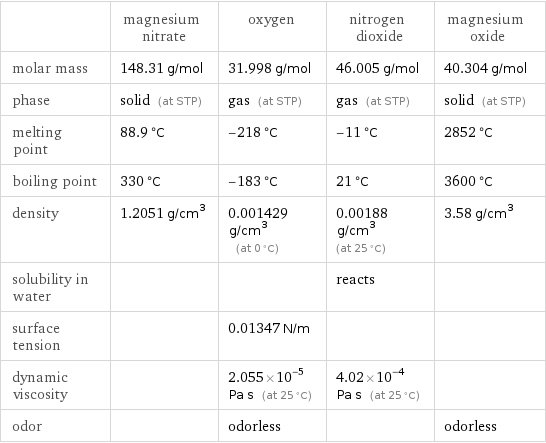
| magnesium nitrate | oxygen | nitrogen dioxide | magnesium oxide molar mass | 148.31 g/mol | 31.998 g/mol | 46.005 g/mol | 40.304 g/mol phase | solid (at STP) | gas (at STP) | gas (at STP) | solid (at STP) melting point | 88.9 °C | -218 °C | -11 °C | 2852 °C boiling point | 330 °C | -183 °C | 21 °C | 3600 °C density | 1.2051 g/cm^3 | 0.001429 g/cm^3 (at 0 °C) | 0.00188 g/cm^3 (at 25 °C) | 3.58 g/cm^3 solubility in water | | | reacts | surface tension | | 0.01347 N/m | | dynamic viscosity | | 2.055×10^-5 Pa s (at 25 °C) | 4.02×10^-4 Pa s (at 25 °C) | odor | | odorless | | odorless
Units
